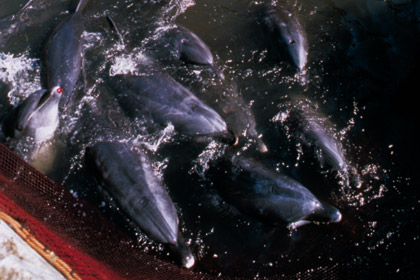Home
Stop
Protect
Connect

Photo by Elsa Nature Conservancy
September signals not only the beginning of the end of another summer, but also the dreaded beginning of a new hunting season in Taiji. The dolphin drive hunts in Taiji, Japan are set to begin on September 1st, and will run through April or beyond.
As we brace ourselves for reports from the field, we are forced to reflect on the complexity of this issue, and our efforts to ultimately stop these brutal hunts. The dolphin drive hunts are a brutal reminder that we have a very long way to go towards securing a safe future for all cetaceans. This devastatingly cruel practice involves the corralling of dolphins at sea and driving them into the confines of the cove in Taiji. Here they are slaughtered for meat or kept alive for sale to marine parks and aquaria across the globe. Yearly government quotas for these drive hunts reach into the thousands, where small whales and dolphins of several species including bottlenose dolphins, striped dolphins, spotted dolphins, false killer whales and short-finned pilot whales, are targeted and killed, with others taken alive for the captivity industry.
The total numbers of dolphins taken last season, and over the course of the last ten years can be found in a report provided by Elsa Nature Conservancy. Over 1,200 dolphins were killed in the 2010-2011 hunt season. Figures provided unofficially by Wakayama Prefectural authorities and by observers on the ground indicate that at least 150 dolphins were taken alive for aquaria last season. Additionally, according to Wakayama authorities, 68 short-finned pilot whales were slaughtered for meat and 6 short-finned pilot whales were captured alive for aquariums during an extended hunting period that occurred last season from May 2-May 31st.
Dolphins from the drive hunts are being shipped within Japan and all over the globe to captive facilities for display and swim-with-the-dolphin programs. More recent shipments of dolphins from the Taiji hunts have been sent to Egypt, Ukraine, Armenia, Thailand, Saudi Arabia, Turkey, Iran and China. WDCS is also investigating the 2010 import of bottlenose dolphins for display at the Constanta dolphinarium in Romania from the Beijing Aquarium in China. Although the Romanian authorities have stated that these dolphins were born in captivity, as the Beijing Aquarium displays dolphins captured in the Japanese drive hunts, WDCS is concerned about the wider impact of international demand for captive dolphins on the continuation of the hunts.
There are no signs from the local authorities that the hunts will cease, and in fact, local police are preparing for the arrival of protesters that have been converging on Taiji since even before the international release of The Cove in June 2009. The movie subsequently won an Oscar for Best Documentary in March 2010 and has motivated a grassroots movement of international and Japanese visitors to the town in hopes of bearing witness and finding a solution to these extremely inhumane hunts.
Although Taiji is the main stronghold of the current drive hunts in Japan, there is also the chance that the village of Futo will restart its drive hunts again. Futo still maintains its quota of nearly 400 dolphins and is permitted to conduct the hunts. The last drive hunt there was conducted in 2004 where 14 bottlenose dolphins were sold to aquariums, 5 were killed for research purposes and distributed for local consumption and one dolphin was released after attaching transmitters. At least 5 dolphins died of shock.
In addition, sources indicate that permits to obtain orcas for aquaria through the drive hunts are still outstanding.
Read more
What WDCS has been doing to stop the hunts ...
What you can do to help us stop the hunts ...
Related programs links
Captivity
Activities
Email a friend
Further links
Site index
Media centre
Search
News
WDCS in action
Support WDCS
WDCS programs
WDCS Science
About whales and dolphins
Adopt a dolphin
Adopt a whale
Adopt an orca
I want to see whales and dolphins
Watching whales and dolphins
Turn the tide
Just for kids
Shopping
Privacy Policy
Publications
Species guide
Terms and Conditions
Contact WDCS
About WDCS
Text Only
Help
Make a Donation
Non visually impaired links
WDCS shop
WDCS germany
WDCS australasia
WDCS north america
WDCS south america
